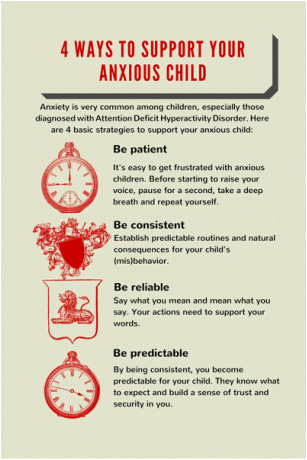
Contrary to the common misconception, having attention deficit disorder does not necessarily mean that a child has a hard time paying attention. The problem is that they pay TOO MUCH attention to everything around them. Kids, who struggle with attention deficit have a hard time filtering external stimuli and outside distractions: what's easy for you to ignore is like a big billboard for your kid. Imagine being in Las Vegas and everywhere you look, there are flashing lights, bright colors and beeping noises, drawing your attention in one direction after another. That's how I imagine a child with ADHD feels every day.
Thus, it is very important that you understand how to support your anxious kid and respond to their sensitivity and emotional needs.
Be patient - It's easy to get frustrated with anxious children. If you ask them to do something, they will probably get distracted on their way to complete the task with an activity, sound, thought or object. Before starting to raise your voice, pause for a second, take a deep breath and repeat yourself. Remind them what they are expected to do and don't take it personally. They are not being disrespectful, they just take longer to do things.
3. Be reliable - Say what you mean and mean what you say. There is nothing more confusing for an anxious child then telling them to do something or threatening them with something that you do not mean and that does not happen. Words lose meaning this way and they lose trust in you as a reliable person. Your actions need to support your words. If you say you are going to do something, do it.
4. Be predictable - By being consistent and reliable, you become predictable for your child. S/he knows what to expect and build a sense of trust and security in you. Predictability, reliability and consistency are the three pillars of secure parent-child relationship that lay the foundation for growth and healthy development. There is room to be spontaneous but it is best saved for play times.
5. Set limits - Limits provide structure and frame the anxiety. As long as they are set in a respectful, healthy way, limits and boundaries create a sense of safety, and lay a solid ground for exploration, play and creativity. Having too much freedom can often create too much anxiety. By providing a structured environment for your child, you help reduce the anxiety and channel your child’s energy into productive, socially acceptable activities.
An example
Finally, something I learned when working in a residential treatment center in Chicago for emotionally disturbed children, many of whom had an ADHD or severe anxiety diagnoses, was to always think about what the child feels and needs at the moment. Oftentimes, they cannot communicate to you verbally what they need or how they feel. Instead, they show you through their actions or behaviors and learning to decode this communication is part of being able to support them and respond to their needs.
For example, instead of saying “Mom, Dad, I am feeling overwhelmed because I do not understand this homework assignment,” they may throw away the assignment book and say something like “I do not want to do my homework! It’s boring!” If you ask yourself the question, “What is my child feeling and needing at the moment” before you respond, you may realize that the homework is too difficult for them and they probably need you to help them complete it. Saying something like, "Do not worry, it is a really difficult assignment. Let's look at it piece by piece and do it together. I can help you," can oftentimes go a long way.
For more articles like this, sign up for Mental Health Digest, your FREE electronic resources on common mental health issues affecting you and your family, plus some suggestions on how to address them, and get the latest issue!



 RSS Feed
RSS Feed